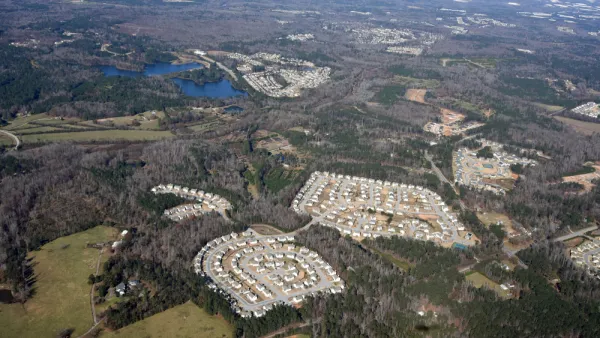Is the challenge of retrofitting sprawl intractable or unavoidable?

Robert Steuteville picks up on a debate from the CNU conference earlier this year about whether "whether sprawl repair is worth the trouble." Steuteville notes first that the debate was surprising, given that "Retrofitting Suburbia was one of top books in the planning field in the last decade" and co-author Ellen Dunham-Jones "has accumulated a database of more than 1,200 suburban retrofit projects under construction or in planning."
Architect Kevin Klinkenberg and development expert Lee Sobel, however, dared to argue that sprawl repair is "a fool's errand." Klinkenberg even penned a blog post in May making this provocative argument: "Suburbia, or sprawl as we interchangeably call it, is all about bigness and mass production," meaning, "it's outside the DNA of walkable cities. Embracing sprawl retrofit is like saying we can transform fast food culture into healthy food."
Steuteville, however, rejects that premise, and proceeds to take on theanti-suburban retrofit arguments, one by one. Those arguments include:
- "Even when suburban retrofit projects are built, the urbanism is far from great." Steuteville's response is that "turning a lousy place into a decent one improves people's lives."
- "Existing urban places are plentiful, so just work in those areas." Actually, argues Steuteville, the supply of urban areas with 19th century and early 20th century street grids is extremely finite, meaning it will never meet demand. "Values will relentlessly increase unless we transform some of the drivable suburban areas."
A final point is that much of what Klinkenberg abhors about sprawl, especially its "bigness," can also be found in cities. So, says Steuteville: "We can't avoid the task of sprawl repair—not even in cities."
FULL STORY: Sprawl repair is essential, unavoidable

Analysis: Cybertruck Fatality Rate Far Exceeds That of Ford Pinto
The Tesla Cybertruck was recalled seven times last year.

National Parks Layoffs Will Cause Communities to Lose Billions
Thousands of essential park workers were laid off this week, just before the busy spring break season.

Retro-silient?: America’s First “Eco-burb,” The Woodlands Turns 50
A master-planned community north of Houston offers lessons on green infrastructure and resilient design, but falls short of its founder’s lofty affordability and walkability goals.

Test News Post 1
This is a summary

Analysis: Cybertruck Fatality Rate Far Exceeds That of Ford Pinto
The Tesla Cybertruck was recalled seven times last year.

Test News Headline 46
Test for the image on the front page.
Urban Design for Planners 1: Software Tools
This six-course series explores essential urban design concepts using open source software and equips planners with the tools they need to participate fully in the urban design process.
Planning for Universal Design
Learn the tools for implementing Universal Design in planning regulations.
EMC Planning Group, Inc.
Planetizen
Planetizen
Mpact (formerly Rail~Volution)
Great Falls Development Authority, Inc.
HUDs Office of Policy Development and Research
NYU Wagner Graduate School of Public Service




























